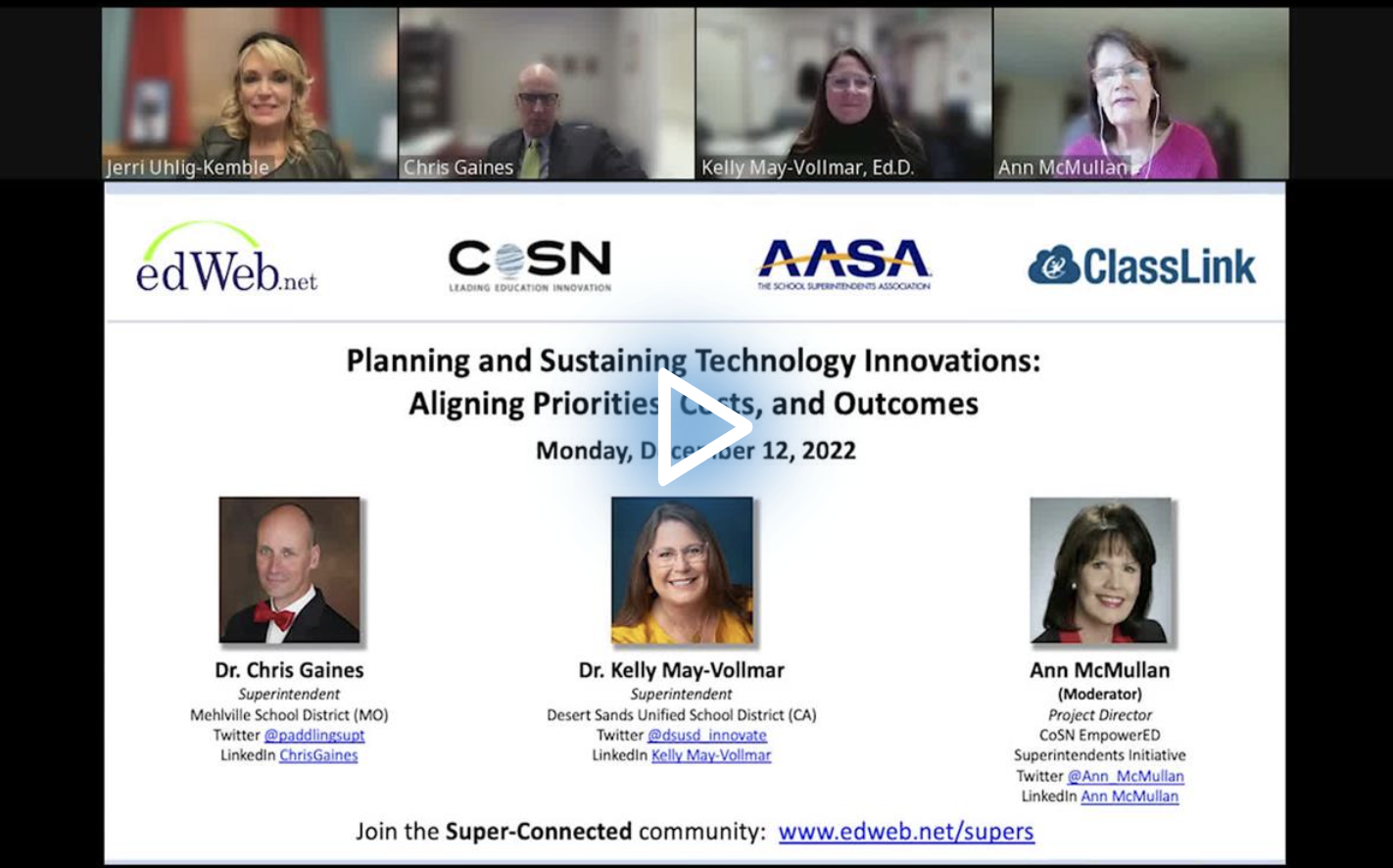Planning for and Sustaining District Technology Innovations
Watch the Recording Listen to the Podcast
This edLeader Panel is presented by CoSN and AASA.
Sponsored by ClassLink
How to balance student outcomes with budgets is a challenge for district leaders. It is especially true regarding smart IT decisions impacting all school district aspects.
During the edLeader Panel, “Planning and Sustaining Technology Innovations: Aligning Priorities, Costs, and Outcomes,” two superintendents addressed the three essential focal points involved in successful strategic technology planning and investment: total cost of ownership (TCO), student outcomes and budget management, and value of investment (VOI).
Total Cost of Ownership
Educational technology comes with direct and indirect costs. Using the total cost of ownership (TCO) analysis addresses the initial investment and the operational and support costs over the life of the investment for a district’s technology environment. A TCO perspective helps all decision makers holistically understand the costs of implementing and maintaining devices and related infrastructure.
Dr. Kelly May-Vollmar, Superintendent of Desert Sands Unified School District (CA), and Dr. Chris Gaines, Superintendent of Mehlville School District (MO), agree that district leaders must be mindful to ensure that chief technology and information officers are engaged in conversations about what they need as part of the decision-making process.
A sound TCO assessment will also provide IT teams with the data to make informed decisions about technology initiatives and investments. According to the two superintendents, it is critical to get executive support, use a baseline, survey users for indirect labor, make educated estimates, include all direct labor, and have as much data as possible.
Student Outcomes and Budget Management
Making technology central to the teaching and learning mission supports the drive to increase student achievement even as budgets shrink. While short-term cuts in IT funding may seem prudent when budgets are on the chopping block, this strategy often leads to increased expenses for the school system in terms of computer downtime and end-user time dealing with technology issues.
Dr. Gaines said, “Our teachers are using technology all the time, whether taking attendance or using the phone to call parents. Technology is infrastructure and gets more costly to replace.” Instead, reframe budget challenges as an opportunity to rethink and strengthen technology investments, operations, programs, staffing plans, and results. According to Dr. May-Vollmar, technology produces more significant student outcomes, and data is central to budget planning and management.
Value of Investment
The decision to approve or amend a specific technology project also deserves strategic thought for investments focused on educationally critical yet qualitative benefits. Value of investment (VOI) is a helpful perspective when working to gain school board approval, articulating costs and benefits, comparing costs and benefits among competing projects, and determining the continuation of projects. The Consortium for School Networking (CoSN) provides a methodology and specific tools to allow K-12 districts to estimate the total costs and expected strategic benefits of proposed technology efforts.
The VOI methodology can help districts evaluate proposed projects, articulate project costs and benefits, and sell and sustain projects. In addition, the two superintendents recommended assessments of proposed projects that include evaluating whether a project is worth doing or offers value, selling the benefits to constituents, and the project’s sustainability when it is time to reinvest.
Collaboration Is Essential
When technology initiatives are viewed as investments rather than costs, it is an opportunity to apply meaningful decision-making analytics in an educational context. A school district’s business and technology departments must work together to achieve successful outcomes.
The Association of School Business Officials International and CoSN created a toolkit to understand the value of a school district’s business and technology departments working together. This resource identifies some common issues impacting the roles of school business officials and chief technology officers and shares best practices, tips, and tools to address them.
The biggest lesson Dr. May-Vollmar and Dr. Gaines have learned regarding planning and sustaining technology innovations is to seek input from end users such as teachers, staff, and students. They are the ones who will be utilizing the technology, so getting their feedback as part of the planning process ensures that the IT solutions provide the expected student learning and growth outcomes.
Learn more about this edWeb broadcast, “Planning and Sustaining Technology Innovations: Aligning Priorities, Costs, and Outcomes,” presented by CoSN and AASA, and sponsored by ClassLink.
Watch the Recording Listen to the Podcast
Join the Community
Super-Connected is a free professional learning community for school superintendents, district leadership, and aspiring district leaders.


ClassLink empowers your students and teachers with instant access to their learning resources. ClassLink® LaunchPad includes a library of over 6,000 single sign-on apps and instant links to file folders at school and on Google, Office 365, Dropbox, and Box cloud drives. ClassLink Roster Server easily and securely delivers class rosters to any publisher using open technology standards. ClassLink Analytics gives decision makers the usage data they need. ClassLink is ideal for 1 to1 and BYOD initiatives.
Blog post by Eileen Belastock, based on this edLeader Panel






Comments are closed.